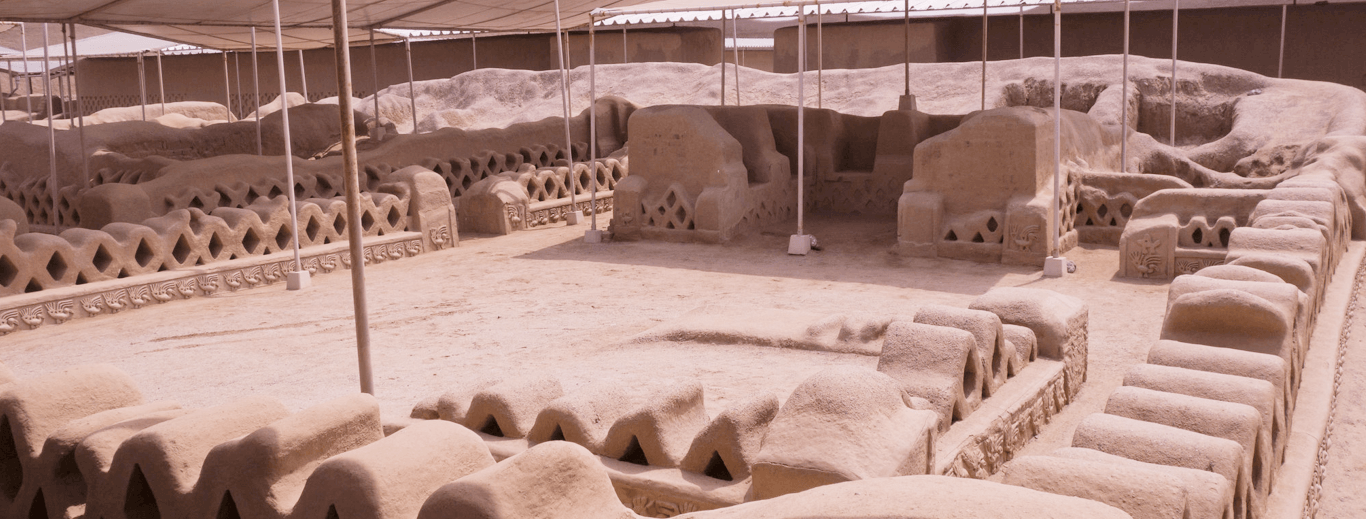Our two-day tour is ideal for exploring the enormous mud labyrinth of Chan Chan and the funerary and ceremonial pyramids of the Huaca of the Sun and the Huaca of the Moon, which are pyramids and temples built by the Chimu culture.
Later, you can relax on the beach of Huanchaco, where you can order lunch directly from the fishermen’s nets.
Enjoy a day of exploring these ancient ruins and enjoy the beautiful landscapes of Peru’s coast.
Itinerary
Day 01: HUACAS SUN AND MOON TOUR – CHAN CHAN – HUANCHACO
We will pick you up at the hotel to start our tour. Starting with a guided visit to the Moche Countryside Museum and a visit to the Huaca del Sol which was the most influential religious center of the Mochica culture.
Afterward, we will visit the Huaca de la Luna, which was a temple and is formed by several superimposed platforms, decorated with paintings and high reliefs with the main characters of the Mochica iconography, such as the figure of the beheader god, Ai Apaec.
Then we will have a tasty lunch and hereafter some free time to rest a little.
Fully recharged we will continue with our visit to the Huaca Arco Iris or also known as La Huaca del Dragon, in the outskirts of the city of Trujillo, located in the district of La Esperanza, then we will visit the Tshudi or Nikan Palace.
Finally, we will enjoy Huanchaco, observing the “Caballitos de Tortora“, the dock and the handicrafts.
At 18.00 pm, our tour will end for the day and we will drop you off at your hotel.
Day 2: CITY TOUR TRUJILLO
The city tour of Trujillo lasts approximately 2 hours, where we will visit the Historical Center of Trujillo (Emancipation House, Casona Mayorazgo de Facalá, Urquiaga House, Orbegoso House, Emancipation House, Iturregui Palace and Toy Museum).
The afternoon is free, you can go shopping and/or spend time in the center of Trujillo.
IMPORTANT: The exact time schedule of the tour will be confirmed in a previous briefing
Included
TOUR INCLUDES
- Transfers from terminal to hotel and vice versa.
- 1-night accommodation
- Breakfast according to hotel’s policies and menu
- 2 days of tour according to program in shared service
- Professional bilingual guide (Spanish/English).
- Entrance tickets to all sites visited.
NOT INCLUDED
- Bus/flight (city of origin to Trujillo and return)
- Meals not described
- Personal expenses and drinks
- Tips
Contact us
More Information
The city of Trujillo
Trujillo, known as the “city of eternal spring” or “capital of the marinera”, is one of the main tourist destinations in the north of Peru.
It is a tourist city that preserves its colonial architecture, considered among other titles the capital of the marinera and cradle of the typical Peruvian Paso horse.
What are the best places to visit in Trujillo?
- Historical Centre of Trujillo
- Huaca of the Sun and the Moon
- Archaeological Complex El Brujo.
- Chan Chan.
- Conache Lagoon.
- Huanchaco Beach.
- Garden of the Senses.
- Pacasmayo.
- Huaca of the Sun and the Moon
- What does the means Huaca del Sol y de la Luna ?
- God Aiapaec Huaca of the Moon,
Legend has it that the Huaca del Sol was built by 250,000 men in 3 days and that more than 140 million adobe bricks were needed to finish it.
And that in the Huaca de la Luna human sacrifices were made. With the excavation carried out, it is known that up to 40 warriors were found inside.
Who was the god Aiapaec?
He was the decapitated god, feared, worshipped, punished and protected the Moches in equal parts.
Who discovered the Huaca del Sol y la Luna?
It was discovered by the German archaeologist Max Uhle who made the discovery at the end of the 19th century.
It was later investigated by Rafael Larco Hoyle, as well as by the archaeologists of the Chan Chan Moche Valley project of the universities of Harvard and California.
How works the huaca of the sun and the moon function?
The huaca of the sun functioned as a political administrative centre, where the upper class of the priests lived.
The huaca of the moon functioned as a ceremonial centre, which is made up of superimposed temples, according to the government of the Mochica power.
How are the huacas built?
They are built of adobe, the natives used the superimposition of structures that gave rise to the formation of platforms. Nowadays, these huacas are considered Monumental Patrimony of the Nation.
Did you know that its adobe structure is one of the largest in pre-Hispanic America?
What culture is Chan Chan?
Although Machu Picchu is the best known archaeological complex in Peru, there are other impressive destinations such as the citadel of Chan Chan, a large complex made of adobe where you will learn about the life of the Chimu culture.
How is the Huaca Cao Viejo built and what material is it made of?
The huaca is a truncated pyramid built of adobe.
It is composed of seven superimposed buildings, built successively over five centuries, following the characteristic ceremonial of the Peruvian coastal cultures: the old building is buried to raise a new one on top of it.
Why is Chan Chan considered the largest mud city in the world?
It is the remains of a pre-Columbian civilization, an adobe city built by the Chimúes, which is the largest adobe city in Latin America and the second largest known in the world.
The “World’s Largest Mud City” is a UNESCO World Heritage Site since 1986.
How were cities built in the Chimú culture?
CHIMÚ ARCHITECTURE: The Chimú were the best architects of Ancient Peru, they used adobe and quincha as raw materials, they created decorations on the walls called friezes or arabesques
(polychrome muralism), they built large buildings with a great urban style like, for example: the city of Chan.
How was Huanchaco created?
The history of Huanchaco goes back to the Moche period. Its famous caballitos de totora are considered to be the precursors of surfing.
With the growth and expansion of the Mochica culture, the coves of Santa Rosa, Eten and Pimentel grew to the north, passing through Chicama, Pakatnamu (Pacasmayo) and others.
What can you do in Huanchaco?
The name Huanchaco comes from Guaukocha (beautiful lagoon with golden fish). Today it is a traditional place and a picturesque seaside resort, an obligatory stop for tourists visiting the province of Trujillo.
At the top of the beach there is a colonial church.
What animals are on the beach of Huanchaco?
Near the pier of Huanchaco you can see seabirds such as pelicans, shearwaters, guanayes and boobies taking advantage of the strange presence on the shore of fish such as anchoveta and silversides which are their main food.
Price
HOW MUCH DOES IT COST?
We have price alternatives that accommodate all budgets, prices per person, expressed in US Dollars.
Make your quotes and reservations by email [email protected], you can also communicate with one of our sales executives at the telephones detailed below, we will be happy to assist you.
Phone – WhatsApp: +51 969 787 221
Phone – WhatsApp: +51 986 994 218
HOW TO BOOK THE TOUR?
To start the reservation process, please send us the following information:
- Name and surname:
- Passport number:
- Nationality:
- Date of Birth:
- Phone:
- Very important – We need the address and information about the hotel that you are staying at, in the city of Salar de Uyuni, to be able to pick you up at the time when the tour starts
To confirm reservations it is required to pay 50% in advance and the other 50% can be paid upon arrival at your destination.
PAYMENT METHODS
- IZIPAY
- PAYPAL
- WESTER UNION
- MONEYGRAM
- TRANSFER TO OUR BANK ACCOUNT PERU
GENERAL CONDITIONS
- All rates for our Peru Packages are expressed in US dollars (subject to currency exchange rates) and are priced per person
- The rates for Peruvians only include VAT
- All our rates are subject to availability and circumstances
- Children under 2 years and 11 months are considered INF (babies) and are not permitted on this tour
- Children from 3 to 10 years and 11 months are considered DCC (child) and thus eligible for special rates and obliged to share the room with their parents
- Children over 11 years old are considered adults
- Minors must travel with an identity document
- Rates do not apply to holidays, Easter, long weekends, national holidays, Christmas, or New Year















